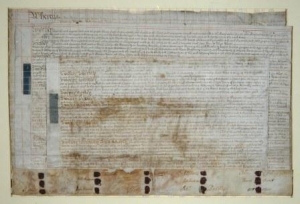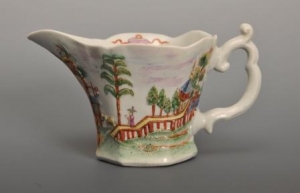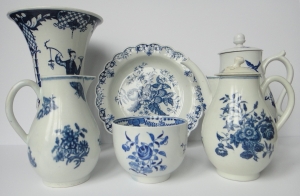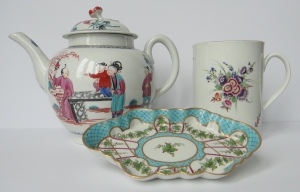12. European Pottery - Fall of Romans to the Present
| 1464 Page: 351 of 418 Go To Page: | ◁◁ First | ◁ Previous | Next ▷ | Last ▷▷ |
12.4 Worcester
Worcester is more a story of commercial rather than family progression. Dr John Wall (a physician) and William Davis (an apothecary) had been carrying out experiments in Davis’s shop in Broad Street around 1750/51 to find a new process of making porcelain. A partnership called the “Worcester Tonquin Manufacture” was set up on 4th June 1751 with Wall, Davis and thirteen investors, several of whom were Quakers. Richard Holdship, a partner, signed a lease on Warmstry House on their behalf on 16th May 1751. Its location on the river Severn made it ideal to transport raw materials and products. Richard Holdship purchased a Cornish steatite mine on his own behalf and had a long-term supply contract with Worcester. The exact date of their first production of soft-paste porcelain in Worcester is not certain, but a sale at a music meeting on 20th September 1752 was advertised in July 1752. The period of production from 1751 until his death in 1776 is known as the Dr Wall period, even though Josiah Holdship ran the pottery until 1762, when William Davis took that role. A very small number of the earliest pots had the name “Wigornia”, the Roman name for Worcester, painted on the base.
In 1752 the acquisition of the short-lived pottery of Miller and Lund (1748-52) in Bristol, together with the licence for Cornish steatite, was negotiated by Josiah Holdship. The arrangement included some moulds and workmen who transferred to Worcester, and probably with help from Lund himself. The Bristol technology and expertise significantly improved the performance, particularly the kiln yield, at Worcester. They produced a soft-paste body, but using steatite (soapstone) from Cornwall that has a low thermal expansion, so, unlike some other English wares at the time, it did not crack or craze when in contact with boiling water. Therefore most of its production was tea and dessert wares rather than figures, although a few of the latter were produced in the 18th century that are now very rare. Initially the decoration was underglaze blue on white in Chinoiserie or oriental styles. Subsequently large quantities of blue and white tablewares were produced. From 1755 overglaze transfer printing was used, particularly after Robert Hancock joined in 1756.
From about 1760, yellow, green, turquoise and claret colours were used over the glaze. Perhaps the best quality wares were in deep cobalt blue either solid or with patterns of overlapping scales – the attractive “blue scale” decoration.

18th century Worcester blue-scale, with birds
courtesy Worcester Porcelain Museum,
and collection with flowers
By 1761 the factory had 200 workers. Robert Hancock was made one of the then six partners in 1772; however, he left in 1774 after a disagreement with the other partners. In 1774 Dr Wall retired and William Davis continued to run the factory until his death in 1783. Thomas Turner was an apprentice at Worcester but left in 1775 and set up the Caughley pottery taking much technology with him, increasing competition.






